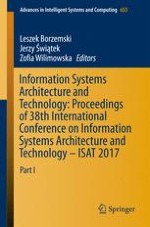This three-volume set of books presents advances in the development of concepts and techniques in the area of new technologies and contemporary information system architectures. It guides readers through solving specific research and analytical problems to obtain useful knowledge and business value from the data. Each chapter provides an analysis of a specific technical problem, followed by the numerical analysis, simulation and implementation of the solution to the problem. The books constitute the refereed proceedings of the 2017 38th International Conference “Information Systems Architecture and Technology,” or ISAT 2017, held on September 17–19, 2017 in Szklarska Poręba, Poland. The conference was organized by the Computer Science and Management Systems Departments, Faculty of Computer Science and Management, Wroclaw University of Technology, Poland. The papers have been organized into topical parts: Part I— includes discourses on topics including, but not limited to, Artificial Intelligence Methods, Knowledge Discovery and Data Mining, Big Data, Knowledge Discovery and Data Mining, Knowledge Based Management, Internet of Things, Cloud Computing and High Performance Computing, Distributed Computer Systems, Content Delivery Networks, and Service Oriented Computing. Part II—addresses topics including, but not limited to, System Modelling for Control, Recognition and Decision Support, Mathematical Modelling in Computer System Design, Service Oriented Systems and Cloud Computing and Complex Process Modeling. Part III—deals with topics including, but not limited to, Modeling of Manufacturing Processes, Modeling an Investment Decision Process, Management of Innovation, Management of Organization.
